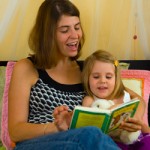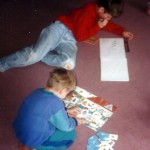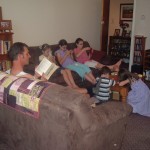 Most people traditionally view read-aloud time as either, 1) a way to promote reading skills, or 2) as something that has to be done for someone until they are independent readers. Though these views are both true, I came to understand the value of reading aloud to my children…my right-brained children… went much further than that.
Most people traditionally view read-aloud time as either, 1) a way to promote reading skills, or 2) as something that has to be done for someone until they are independent readers. Though these views are both true, I came to understand the value of reading aloud to my children…my right-brained children… went much further than that.
First, for right-brained learners, it develops their important pre-reading skills. Because reading acquisition tends to begin between the ages of 8 and 10 for right-brained children, the pre-reading skills are often most developed between the ages of 5 and 7. These include (from my book):
- Building a library of pictorial images
- Developing strong visualization skills
- Enjoying a positive relationship with print
Listening to read-alouds particularly develops the last two skills. From my book, The Right Side of Normal, I elaborate on how read-aloud time develops their strong visualization skills:
Read-aloud times with my two oldest children revealed how well this activity develops the visualization skill. During or after a reading, my two oldest children  frequently talked to each other about the characters in the story and compared their drawings and visualizations. They asked me what I thought various characters looked like and offered to draw them for me. I realized how visual my children are, down to minute details they can replicate on paper. I “feel” characters with more of a fuzzy visual image, which I can connect to another visual character or person I’ve seen before, because I can’t conjure a visual image for myself. Once, during a read-aloud, I shared a visual representation of a character, and my artist son was shocked. According to him, my rendering was completely inaccurate of the author’s original description. I was shocked when he searched for and found the character description in the book series, two books earlier, within about five minutes. Now that’s amazing visual memory!
frequently talked to each other about the characters in the story and compared their drawings and visualizations. They asked me what I thought various characters looked like and offered to draw them for me. I realized how visual my children are, down to minute details they can replicate on paper. I “feel” characters with more of a fuzzy visual image, which I can connect to another visual character or person I’ve seen before, because I can’t conjure a visual image for myself. Once, during a read-aloud, I shared a visual representation of a character, and my artist son was shocked. According to him, my rendering was completely inaccurate of the author’s original description. I was shocked when he searched for and found the character description in the book series, two books earlier, within about five minutes. Now that’s amazing visual memory!
I continue in my book how right-brained children engage in read-alouds very differently than the stereotype we expect in order to enjoy a positive relationship with print:
As noted consistently throughout this book, listening to read-alouds and audio books is a key skill-building activity for right-brained children. But, it has to be done their way. Initially, I thought read-aloud time meant my children sitting in my lap or next to me on the couch and looking mesmerized into the book as I  read each page. This wasn’t typically true of my right-brained children. My children always drew, colored, or built LEGO® as they listened to the reading. I could never do that! I have to concentrate when I listen to someone read. What I discovered is many right-brained learners need to “turn on” their creativity (housed on the right side of the brain) to attend to a passive (listening) or left-brained (translating words to pictures) activity. Their independently chosen creative pursuit engaged the right side of the brain so they could be at peak focus. Right-brained children are simply using their best assets to create a positive relationship with print.
read each page. This wasn’t typically true of my right-brained children. My children always drew, colored, or built LEGO® as they listened to the reading. I could never do that! I have to concentrate when I listen to someone read. What I discovered is many right-brained learners need to “turn on” their creativity (housed on the right side of the brain) to attend to a passive (listening) or left-brained (translating words to pictures) activity. Their independently chosen creative pursuit engaged the right side of the brain so they could be at peak focus. Right-brained children are simply using their best assets to create a positive relationship with print.
Second, listening to read-alouds is a support for right-brained children as they become fluent readers. From my book:
Remember, many skills are needed for a right-brained child to read a book: decoding words, translating words to pictures, creating an overall visual from that translation, and comprehending the translation. The hardest skill for an early right-brained reader to learn is the decoding part.
In other words, the most natural part for a right-brained reader is to translate  the words into a visual. The most motivating reason for a right-brained child to want to read is to get lost in the imaginative worlds created or to find out something they’re interested in. Therefore, if they continue to sit in on read-alouds as they work through the left-brained task of decoding, it protects their positive relationship with print as they become fluent. Here are the benefits I recognized my pre-fluent right-brained children gained through read-aloud times, as taken from my book:
the words into a visual. The most motivating reason for a right-brained child to want to read is to get lost in the imaginative worlds created or to find out something they’re interested in. Therefore, if they continue to sit in on read-alouds as they work through the left-brained task of decoding, it protects their positive relationship with print as they become fluent. Here are the benefits I recognized my pre-fluent right-brained children gained through read-aloud times, as taken from my book:
- Read-aloud time assists in fluency because they are “catching the visual.” When they re-read the book themselves, the translation process has already been done once.
- Read-aloud time supports the ability to “turn on” the right side of the brain by engaging in a creative activity while listening, such as drawing or building with LEGO®, to better focus on developing a left-brained skill (translating words).
- Read-aloud time protects the positive relationship with print during the (up to 2 year) transition from early reader to fluent reader.
- Read-aloud time allows the continuation of enjoying the process of hearing a story while slowly integrating the newer left-brained skills (decoding words) required for independent reading.
So even after reading fluency is accomplished, joining read-aloud times supports the preference of the process of reading, which is enjoying the story. For read-alouds, as the left-brained person, I still prefer to be the reader. It’s more enjoyable for me. My right-brained children and husband still prefer to listen to the read-aloud. It’s more enjoyable to them. A successful integration of left-brained skills doesn’t supersede the ease and preference of the inherent enjoyment from using one’s own preferred skill set. Read-aloud time is one strategy that supports the process of enjoying a story for right-brained children that leads to a painless transition of the product of independent reading acquisition.
Stephanie, from my yahoo group Homeschooling Creatively, shares this about the benefits of read-alouds and audio books during the pre-fluency stage for her oldest son:
One of the key tools in the beginning was read-alouds and audio books. My oldest son’s comprehension level was always above his reading level so audio books allowed him to enjoy the books that interested him. They also help him  practice translating words into the pictures in his head (this is a key skill for right-brained kids–Remember, they see pictures in their heads so they have to not only be able to read the word, but also translate it into a picture. My oldest son used to tell me that he could see the pictures more easily if he listened to a book–as he read more, he got better at doing this while reading as well). There are so many great things about audio books and they *very* much “count” as reading practice/instruction, etc. My oldest son still devours audio books and listens to them every night before bed (while he is falling asleep, after he finishes reading before bed…LOL!)
practice translating words into the pictures in his head (this is a key skill for right-brained kids–Remember, they see pictures in their heads so they have to not only be able to read the word, but also translate it into a picture. My oldest son used to tell me that he could see the pictures more easily if he listened to a book–as he read more, he got better at doing this while reading as well). There are so many great things about audio books and they *very* much “count” as reading practice/instruction, etc. My oldest son still devours audio books and listens to them every night before bed (while he is falling asleep, after he finishes reading before bed…LOL!)
Third, it’s a model for incidental teaching many subjects. Grammar and writing are modeled by being able to hear how good grammar and writing sounds. By being able to hear reading with inflection, we show that good writing draws a person into another world. One’s vocabulary naturally increases as diverse exposure to words are absorbed. I have no doubt that my oldest gifted artist son picked up all he needed for grammar, writing, comprehension, and vocabulary from read-aloud times.
My builder son, however, didn’t gain a lot of these benefits because he avoided joining our read-aloud times due to his weak auditory input and processing. His overall language deficits due to living with high functioning autism also impacted his ability to gain from listening to read-alouds at a younger age. His benefits  with reading came later. In middle school, he was trying to build up his vocabulary with a separate resource. Although it was easy for him to memorize the various vocabulary words because of the good matching resource, it was difficult for him to integrate it into his daily life. It was also difficult for that method to positively impact his overall comprehension. It suddenly occurred to me that he reads at the level of his current vocabulary, and the only way to increase his language level was through reading books that pressed him slightly over his current language ability. In high school, that’s what he did to more effectively increase his overall vocabulary and comprehension.
with reading came later. In middle school, he was trying to build up his vocabulary with a separate resource. Although it was easy for him to memorize the various vocabulary words because of the good matching resource, it was difficult for him to integrate it into his daily life. It was also difficult for that method to positively impact his overall comprehension. It suddenly occurred to me that he reads at the level of his current vocabulary, and the only way to increase his language level was through reading books that pressed him slightly over his current language ability. In high school, that’s what he did to more effectively increase his overall vocabulary and comprehension.
Linda, from my Homeschooling Creatively list, shared the benefits her children gained from read-aloud time:
 In my experience (I read aloud to my kids until they were 14 and almost 16), being read aloud to by an adult (or any good reader) has some huge advantages over just reading silently to themselves, when kids are younger.
In my experience (I read aloud to my kids until they were 14 and almost 16), being read aloud to by an adult (or any good reader) has some huge advantages over just reading silently to themselves, when kids are younger.
One of the advantages is that they hear how words are pronounced.
Another is that they learn more vocabulary that way – assuming that they ask and you tell them the meanings of words that are new to them. Kids who read to themselves are much more likely to guess at the meaning of a new word from its context than to stop reading to look it up. When I read to my kids, I always kept a dictionary or a laptop computer open to dictionary.com within reach. If I didn’t know the exact (or best) definition for a word, I looked it up and read the definition to them. (By doing it myself, and not making it a task/chore for the kids, they never came to associate looking up information with coercion or tediousness or something to be avoided, and they just picked up the habit of looking up definitions and other information themselves – which is very helpful for college students!)
Another advantage is that the children hear the stories (or information content, etc) with inflection, emphasis, and pauses, and all the other things that make the language more meaningful than *just* the words. So when they start reading to themselves more at an older age, their language skills are already more developed, and their comprehension is more complete.
 It’s also a really good way to start conversations about various aspects of all the stories and information that you’re reading to them.
It’s also a really good way to start conversations about various aspects of all the stories and information that you’re reading to them.
My kids and I are really into sci-fi and fantasy. We used to have lots of interesting conversations about real science, history, civics/sociology, psychology, mythology, etc, based on things that came up in the stories. We also *occasionally* talked about the authors, their backgrounds and the parts of their personalities that were very evident from their writing, their writing style, and various writing-style and literary topics. It was just casual conversation, but my kids learned a lot from it, and they and I enjoyed it! My daughter and I still enjoy reading aloud to each other and discussing books! (We also enjoy watching and discussing/critiquing movies, videos, TV shows, and seeing live plays. To me, it’s all literature – whether you take it in through reading, listening, or watching it acted out.)
Like Linda’s situation, my older children enjoyed read-alouds until they were 16 and 18! Benefits occurred throughout their reading stages of development. The last benefit I wanted to share was the family bonding and interest-sharing we enjoyed. I wrote an article about it that appeared in Home Education Magazine once upon a time. I absolutely treasure my read-aloud season with my children. Read-aloud time may not be a structured program, but the value of read-aloud time are innumerable, and this post highlights only a handful.
Question: What benefits have you noticed read-alouds or audio books provide?






Pingback: Your Child Might Be Right-Brained If … | The Right Side of Normal